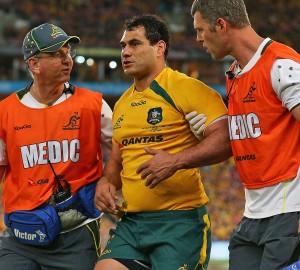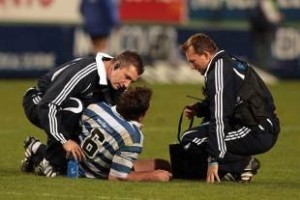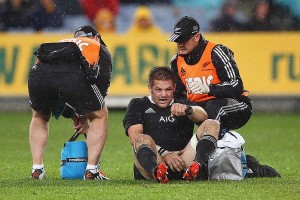
George Smith: the picture that sparked a thousand and more discussions.
We all remember it: the vision of a glazed and vacant George Smith staggering from the turf at ANZ Stadium, led by a medic at each elbow, after a sickening clash of heads with British & Irish Lions hooker Richard Hibbard handed him a one-way ticket to cuckoo-land.
We remember it was upsetting to see the great warrior reduced to a helpless lump.
We remember how sad it seemed that his comeback in the third Test- billed as a fairy-tale finale – had apparently been curtailed so quickly.
And we remember, of course, the hapless call to return him to the action that sparked the concussion debate that – more than one year on – continues to envelop the Australian sporting fraternity.
The PR-disaster that was Smith’s return to play, and the queue of experts, journalists and ex-players lining up to bash the Australian Rugby Union with a very large stick was not lost on the board.
Their subsequent appointment of a dedicated concussion specialist, with the remit to oversee and safeguard those on the front line at all levels of Australian rugby, was due in no small part to the enhanced scrutiny the game found itself under in the months that followed.
Dr Ryan Kohler is a forthright Cape Town native who has seen more concussed rugby players than hot dinners, boasts more letters after his name than in it. And he is the right man with whom the ARU is working.

Dr Ryan Kohler attends to Corne Krige
He developed the South African Rugby Union’s first concussion protocol way back in 2001.
In 2003, together with Dr Jon Patricios, he founded Sports Concussion South Africa, a national community concussion program that continues to provide resources to schools and clubs.
For more than a decade, he worked first as the Stormers and Springboks team doctor then with the Brumbies as their match-day medic through the dark days of concussion suppression, trivialisation and 30-second, on-the-run assessments.
It’s not a bad CV.
Now, as well as his one-day-a-week consultancy role with the governing body, he runs his own national sports concussion program in Australia, liaising with schools, clubs, players and parents in an effort to raise awareness of the dangers a blow to the head may carry.
“We’re now in a position where we will simply not have another George Smith, certainly at Test level, and I’m confident we won’t have one at Super Rugby level, either,” Kohler tells ESPN.
That’s a bold statement, especially after the gross mismanagement of reeling Toulouse centre Florian Fritz in the French Top 14 just four months ago – an incident that bore frightening similarities to the Smith debacle
But Kohler is no stranger to frankness. In March 2013, after a Deakin University study revealed numerous retired athletes were suffering long-term problems thought to be caused by repeated collision sports concussions, he told The Age: ”I would be surprised if today’s generation had any kind of long-term problems because of concussion, and that’s on the basis we don’t even know if those players in the ’80s did, either.
“My focus is different,” he tells ESPN. “Yes, we need to understand concussion effects through research, but we can’t turn the clock back. What happened 20 years ago with retired players happened, and it’s regrettable that some claim to have cognitive problems from head impacts.
What we can change is what we do today, and if we put the policy, protocols and effort into changing what people do around concussion, well 20 years down the line hopefully we don’t have the same claims cropping up.”
Kohler’s ARU gig takes him from the ‘tradies’ to the top. He has acted as the independent concussion doctor for all of the Wallabies Tests on home turf in 2014, and he argues the enhancement of the IRB’s pitch-side screening tool (the Head Injury Assessment) coupled with the use of video replay makes for a far more robust and reliable system.
Indeed, with a concussion specialist waiting in the wings, he reckons most team medics will sooner refer a stricken player than risk making the wrong call and copping the inevitable public flak. But maybe that’s no bad thing.
“What I’ve found is that most team doctors would rather not do the concussion assessment; they would rather pass that responsibility onto me.
The team doctors are looking to pass that ball to the concussion doctor and deal with the musculoskeletal injuries. Then after the game, they move into concussion management again in doing the follow-up assessments on their players.”
Kohler readily accepts that questions may arise over his ‘independence’ while he remains on the ARU payroll; it’s a tough call to haul Richie McCaw off for assessment during a delicately poised Bledisloe Cup Test, but it becomes even harder when you’re employed by the opposition.

Richie McCaw’s injury “looked like a stinger… but on video replay he took a head knock”.
“Richie went down twice in the Sydney Test; it looked like a stinger, he was shaking his hand, but on video replay he took a head knock.
You’ve got to have very good evidence and good reason to pull opposition players off, or at least overrule their team doctor, and it could be conceived as bias.
To combat this, I suggest working under the IRB banner, in much the same way as the other sideline match officials, then perception of any bias or conflict of interest is lessened. Ultimately it’s going to come down to money and whether the IRB agree to fund independent concussion doctors across the world. There would need to be at least two that covered Tests in each country.”
It’s the recreational scene that demands the bulk of Kohler’s attention.
Science tells us the developing brain of the youth or the adolescent renders them most susceptible to serious – sometimes tragic – consequences that can arise from a head injury. But within the rigid structure of schools governance, Kohler has found the practicalities of informing and enforcing far less challenging than in the amateur ‘club land’, the welfare wilderness where players are “more concerned with when they’re going to have their first beer than when they’re going to be seen by a doctor”.
“For the tradies, it’s really about getting into the clubs and trying to disseminate information. Raising awareness, educating the coaches, and trying to get them to understand that they need to speak up and tell their coach they have a head injury and don’t feel well.
That’s where I put most of my energy at the moment.
“But I believe we may need to be creative, or possibly incentivise them; give them something tangible – like a baseline test result – that acts as a reminder of what they’re doing. But there are more questions than answers at this stage.”
Baseline testing is a touchy subject.

Rory Lamont: “It isn’t the metal plates in my face that bother me, it’s the unseen damage of concussion”.
Even in the modern era, stories abound of players who deliberately ‘sandbag’ these pre-season assessments, recording a deliberately poor score so their benchmark to return to play is lower when they are tested months later, post-concussion. Kohler is confident that software and technology improvements mean this is no longer possible, but doubts will inevitably linger.
If carried out effectively, there is little doubt they form a very useful part of the recovery process, but can we really and practically subject every player in Australia to this form of testing?
“It’s probably a difficult thing to do. But I believe you still need to give the community the opportunity to have the same tests that elite players have. The tests are accessible and affordable, and make a big difference to overall concussion management.
“Some form of baseline testing is very helpful. If everyone can have some form of computerised baseline testing and, coupled to that, education, then that’s first prize. How often do you get five minutes to do one-to-one player concussion education? What a unique opportunity. It’s those two in equilibrium that make a difference.
“But often the doctors end up seeing players who don’t have any form of baseline, and then it becomes a lot more difficult to determine when these players are back to themselves. You can’t really apply a population norm, as you get some people who test normally but aren’t up to their own standards.
“So I’m not saying it’s mandatory to go and have baseline testing. I am saying you have to recognise concussion and get those athletes the heck off the field. But to get to that point something needs to happen first; that something is education and/or testing.”
Clearly, logistical and attitudinal problems persist. And despite the positive steps taken, Kohler – perhaps most worryingly of all – recounts numerous tales of pushy parents champing at the bit to have their child back on the field ahead of time.
“It’s been alarming and surprising that some of the people who most want the player back on the pitch are the parents. That’s been a bit of a mind-blower for me.
The parents want their kid back on the field sooner rather than later … I haven’t worked that one out yet. That’s my grassroots experience, working day in and day out, chatting to so many people … I don’t know how or why that attitude came about, but clearly parents need to be educated as well.”
The IRB will repeat their mantra of “driving cultural change” to anyone who cares to listen, but, in real terms, what does that phrase mean?
“The concept of being soft or sucking it up is being challenged at this point.
In my community program, my message to the kids is: you’re not soft; your brain is soft. Everyone’s brain is soft. Even the Wallabies’ brains are soft. Attitude and behaviour need to change, not just attitude. So speak up, and tell your coaches or parents how you’re feeling.
“At the elite level, some codes are fining teams for concussion mismanagement. The ARU are taking an educational approach to spread the concussion message, and we’re taking every reported case seriously.
I’ve just written to a club asking for feedback on a particular case that was managed … let’s just say sub-optimally, and I think that’s the start. We can have guidelines, but we’ve seen that they don’t always get followed.
“We’ve discussed the idea of adopting a policy that gives us an enforcement capacity to concussion management. We don’t want to be seen as concussion policemen, but at some point people have got to realise they have a responsibility and a duty of care.”